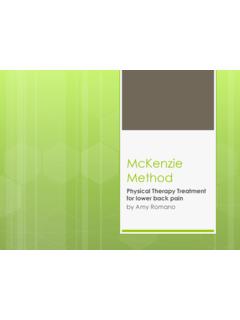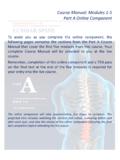Transcription of Nutrient Management of Irrigated Alfalfa and Timothy - AITC
1 Nutrient Management of Irrigated Alfalfa and Timothy Irrigated Crop Production Conf. Lethbridge, AB. Jan 19, 2016. Ross H. mckenzie Old Agronomist Lethbridge Introduction Alfalfa and Timothy are excellent crops to include in an Irrigated crop rotation. Both have high Nutrient requirements demands for soil nutrients. Both use up to 4 to 5 inches of water for each ton of dry matter produced. Outline: 1. Benefits of forage in crop rotation 2. Soil testing and analysis 3. Nitrogen and N fixation 4. Phosphorus 5. Potassium 6. Sulphur 7. Micro's Benefits of Alfalfa & Timothy in the Crop Rotation Benefits of Forage in a Crop Rotation Increased soil quality and soil health Increased soil organic matter and soil carbon levels Improved soil structure Increased water infiltration and internal drainage Increased soil fertility and increased nitrogen release benefits Reduced nitrogen fertilizer requirements for several years after Alfalfa Reduced weed and disease pressure Increase yields of following crops Nitrogen Benefit After Alfalfa N fertilizer can be reduced by Up to 50% the first year after Alfalfa .
2 30% the second year after Alfalfa Wheat protein increased by up to 2% after Alfalfa Nutrient Requirements Alfalfa Nutrient Removal Nutrient 6 Tons (lbs/ac). Macronutrients Nitrogen (N) 300+. Phosphate (P2O5) 60 - 75. Potassium Potash (K2O) 250+. Sulphur (S) 30. Calcium (Ca) 150. Magnesium (Mg) 30. Micronutrients Boron (B) Copper (Cu) Iron (Fe) Manganese (Mn) Molybdenum (Mo) Zinc (Zn) Timothy Nutrient Removal Nutrient Amount Removed (lbs/ac). 5 Tons Macronutrients: Nitrogen (N) 200+. Phosphate (P2O5) 50. Potash (K2O) 200. Sulphur (S) 25. Calcium (Ca) 150. Magnesium (Mg) 25. Micronutrients: Boron (B) Copper (Cu) Iron (Fe) Manganese (Mn) Molybdenum (Mo) Zinc (Zn) Soil Sampling and Testing Why Soil Test? Gives an excellent inventory plant available nutrients soil chemical factors important for crop production.
3 Provides a basis for recommending additional nutrients. Soil Sampling: Depths: 0-6 . 6-12 . 12-24 . 0-6 - N, P, K, S, pH, EC + micro's*. 6-12 - N, P, K, S, pH, EC + micro's*. 12-24 - N, S, pH, EC. * Before establishment Soil analysis: Modified Kelowna extractant is used for: NO3-N, P and K. Don't use Bray or Olsen methods!! CaCl2 is used to extract SO4-S. DTPA is used for metal micronutrients Cu, Fe, Mn and Zn Hot water is used to extract Boron Nitrogen (N) Nutrition of Alfalfa Nitrogen and Alfalfa : N fertilizer is rarely required on established Alfalfa . Alfalfa can "fix" its own nitrogen (N) with Rhizobium meliloti, a bacteria that lives in association with roots. Bacteria form nodules on the plant roots and convert nitrogen gas (N2) from the air, into a form that plants can use. Alfalfa is effective at fixing N.
4 A 6 ton/ac Alfalfa crop can fix up to 300+ lb/ac of N/yr. Nodules contain bacteria which fix N for Alfalfa growth N fixation: Alfalfa seed must be inoculated with R. meliloti. N-fixation by Alfalfa may decline after a stand is 4 or 5 years old. Poor yielding stands should be terminated and seeded to an annual crop for several years before being reseeding to Alfalfa . Nitrogen for Timothy 0 N 180 lb N/ac Urea Spring Broadcast Timothy Lethbridge June 13, 2006. 90 Urea N 45 lb N/ac Urea Spring Broadcast Timothy Lethbridge June 13, 2006. 135 ESN N 135 lb N/ac AN. Spring Broadcast Timothy Lethbridge June 13, 2006. 45 AN N 45 lb N/ac Urea Spring Broadcast Timothy Lethbridge June 13, 2006. 45 AN N 90 lb N/ac ESN. Spring Broadcast Timothy Bow Island June 19, 2006. N Rates for Timothy Spring for first cut: 120 to 135 lb N/ac - very early spring Immediately after first cut is off: 70 to 100 lb N/ac irrigate immediately after Timothy Nitrogen Choices Spring broadcast urea (46-0-0).
5 Best option if broadcast very early in spring (when very when soil is cool !). Watch weather forecast and consider volatilization potential Spring broadcast ESN. NO release rate is TOO SLOW! Spring broadcast Agrotain coated urea (46-0-0). Higher fertilizer cost for 10-12 days of protection from volatilization! Good option if weather conditions are warm and windy Spring dribble banded UAN liquid (28-0-0). Good option but consider volatilization potential apply in early spring! Consider the higher cost of liquid N. Can add Agrotain to liquid for 10 to 12 days of protection from volatiliztion! Spring broadcast Ammonium sulphate (21-0-0-24). Short term option No N loss but will apply S at high rate Not preformed well in our winter wheat work Ammonium nitrate (34-0-0). Best product BUT must import from USA Good Luck!
6 ! Phosphorus (P) Nutrition Phosphorus Alfalfa and Timothy have a high requirement for phosphorus (P). Most Irrigated soils in Alberta are naturally low in plant available P. Residual P levels vary in Irrigated soils Many fields have received phosphate fertilizer Manured fields usually have adequate P and K. Soil testing is strongly recommended before establishing Alfalfa to determine P requirements P Fertilizer Application Before Forage Establishment A large single application of P fertilizer or the application of manure or compost before establishing Alfalfa or Timothy is very effective to add P to soil. An application of 150 lb/ac of P2O5 before establishment. Phosphate fertilizer can be either banded or broadcast-incorporated prior to seeding Alfalfa or Timothy . Phosphorus Fertilizer Established Forage If soil P is < 90 lb/ac or if P was not applied before establishment Apply 50-60 lb/ac of P2O5 (Granular 11-52-0; 12-51-0).
7 Broadcast in early spring every year Under moist conditions, Alfalfa and Timothy have feeder roots near the soil surface that can take up broadcast P with reasonable efficiency. Can use dribble applied or can fertigate with liquid P. fertilizer (10-34-0). Manure or Compost is an excellent source of P. 0 P2O5 54 lb P2O5 /ac Spring Band Timothy Lethbridge June 13, 2006. Phosphate Fertilizer P2O5. 2006 Lethbridge First Cut 6000 kg P2O5/ha 0. 5000. 30 Br 60 Br Yield (kg/ha). 4000. 30 Bd 3000 60 Bd 0 + 200. 2000 30 Br + 200. 60 Br + 200. 1000 30 Bd + 200. 60 Bd + 200. 0. Phosphate Response - Method & Rate Potassium (K) Nutrition of Alfalfa Potassium Alfalfa and Timothy have a high requirement for potassium (K). If soil K levels are less that 200 lb/ac of K (Kelowna or ammonium acetate extractable K), in the 0 to 6 inch depth K fertilizer is recommended and may need to be coupled with annual applications.
8 Most Irrigated loam and clay loam soils have adequate soil K! K is most commonly deficient on very sandy soils that are more intensively cropped. Use a soil test to determine if soil K levels are low or deficient. Annual Potassium Fertilizer Recommendations for Alfalfa and Timothy . Soil Test K Potassium (K2O ) Recommendations (0-6 inches) (lb/ac). 0 50 150 170. 50 100 100 - 120. 100 150 90 100. 150 175 50 60. 175 200 40 50. 200 250 25 50. >250 0. Note: Based on the Kelowna or ammonium acetate soil K test method. Placement and Application Options Establishment Broadcast K to build up soil test K before seeding Maintenance Apply following harvest to replace removal When soil K levels are high K fertilizer application can lead to high K. levels in forage which is not desirable! Sulphur (S) Nutrition Sulphur on Irrigated Land S fertilizer is rarely required for perennial crops: Subsoil is usually relatively high in sulphate-S roots have access to this S.
9 Approximately 30 lb S/ac is applied in 12 . of irrigation water in the Sulphate form! Calcium and Magnesium - Not Needed - in southern Alberta - Base Saturation method used to predict Ca and Mg is flawed practice. - Should not be used to make recommendations! Micronutrient Needs of Alfalfa Low Soil Levels Nutrient Low Soil Level Boron < ppm in 0-6 Soil test is not reliable Copper < ppm in 0-6. Iron < ppm in 0-6 . Manganese < ppm in 0-6 . Zinc < ppm in 0-6 . -Micronutrients are not normally deficient -Deficiencies may occur on very sandy, low organic matter soils that are intensively cropped! -If soils test low try strips first! Summary Nitrogen Inoculate Alfalfa seed before seeding Timothy 120-135 lb N/ac in early spring and 70- 100 lb N/ac for second cut Phosphorus - If soil P is low . Apply P2O5 before establishment 150 lb/ac Annual application ~50-60 lb P2O5/ac Potassium (Potash fertilizer).
10 Only needed if Soil Test K is <200 lb/ac Sulphur and Micronutrients rarely needed! Ross H. mckenzie Lethbridge, Alberta Phone: 403-328-1001. Questions ?







